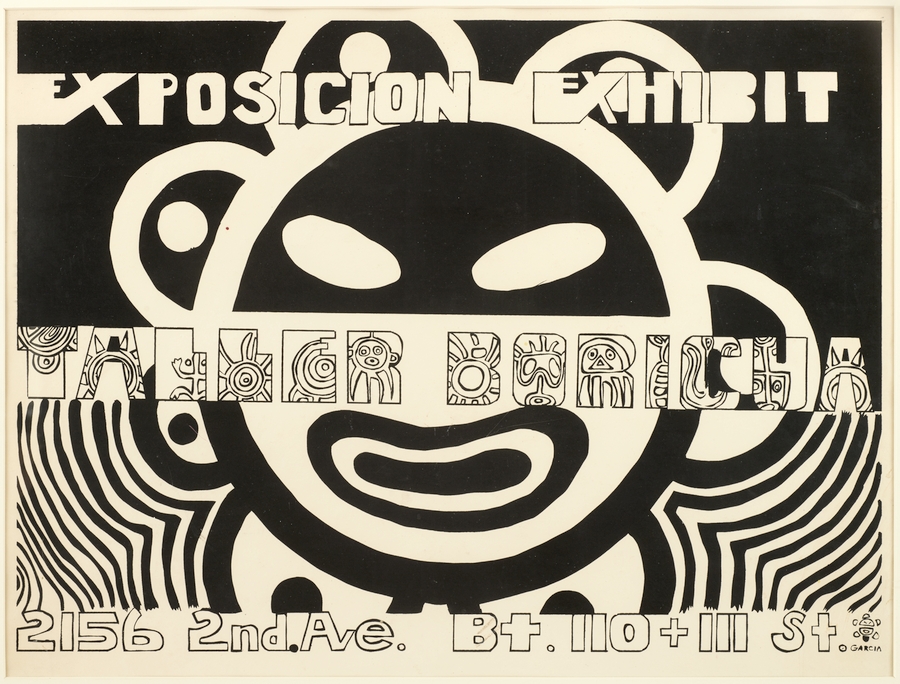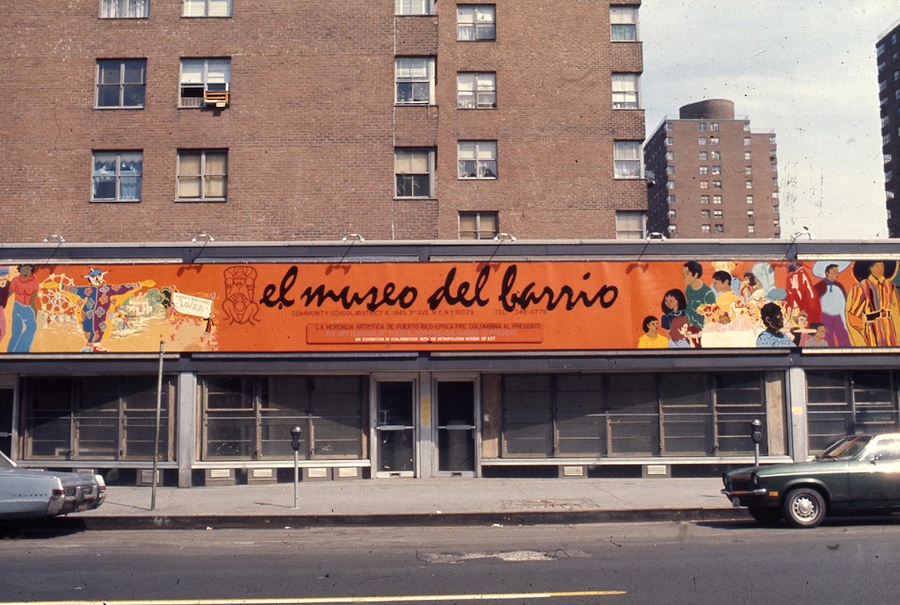
TALLER BORICUA: A POLITICAL PRINT SHOP IN NEW YORK
In celebration of Taller Boricua’s 50th anniversary, El Museo del Barrio presents Taller Boricua: A Political Print Shop in New York, the first monograph exhibition in three decades about the East Harlem-based Nuyorican collective workshop and alternative space. Best known for its cultural empowerment and political activism, the organization commonly known as ‘The Puerto Rican Workshop,’ which began as a printmaking studio, produced and circulated hundreds of prints by artists. The prints, produced mainly in the 1970s, centered on issues of Puerto Rican independence, workers’ rights, and anti-imperialism both locally and in the Caribbean and Latin America, issues that remain relevant today.
Curated by Rodrigo Moura, Chief Curator of El Museo del Barrio, the exhibition is comprised of more than 200 works and ephemera, including serigraphs, lithographs, linocuts, paintings, assemblages, collages, and drawings by founding and early members, including Marcos Dimas, Carlos Osorio (1927 – 1984), Jorge Soto Sánchez (1947 – 1987), Nitza Tufiño, and Rafael Tufiño (1922 – 2008), among several others. Works in the show draws from El Museo’s Permanent Collection, Taller’s extensive archives, as well as other collections.
A recognized space for political activism, Taller Boricua is one of several Puerto Rican organizations created in New York City around the same time, as the Young Lords and El Museo del Barrio, and has mentored several generations of artists, art historians, and curators. The space served as a focal point for the affirmation of identity as it relates to artistic production in the diaspora, as well as its connections with non-Western art history narratives. Focused on its first decade of existence, the exhibition also looks at the close relationship between Taller Boricua and El Museo del Barrio, examining their common members, ethos, and the artists’ role in the creation of a visual identity for the Museum’s programs and exhibitions in its early years.

THE WORKSHOP/THE MUSEUM
Taller Boricua was founded in 1970 as an artist run studio in El Barrio, by Marcos Dimas, Adrian García, Manuel “Neco” Otero, Martin Rubio, and Armando Soto, at the headquarters of the Real Great Society, an urban planning collective, on Madison Avenue at East 111th Street. That same year, Dimas, Soto, Rubio, and García became advisors to the recently founded El Museo del Barrio. Together with Rafael Montañez Ortiz, one of the founders of El Museo, these artists had participated in the Puerto Rican Art Workers Coalition, which pushed for the representation of women artists and other minorities in New York museums.
The posters and ephemera presented in this section, created by Taller Boricua artists, document the first years of collaboration between Taller and El Museo, including exhibitions during director Marta Moreno Vega’s tenure, such as Exposición Rodante. Taller Boricua, the group’s first exhibition in the museum, in 1972. During this shared history, there were also moments of disagreement between the two organizations. In the exhibition The Art Heritage of Puerto Rico: Pre-Columbian to the Present (1973), co-organized by El Museo and The Metropolitan Museum of Art, members from Taller Boricua organized a demonstration during the opening to protest against their exclusion from the show.



A POLITICAL EDUCATION
The works exhibited in this gallery make recurring use of iconography based on the political history of Puerto Rico, connecting political struggles on the island with the artistic context of the United States. They also refer to the colonial relations between the two nations and thus provide a political education through images to the population in the diaspora. Printmaking, the main technique utilized by artists in this gallery, plays a fundamental role in this task. It offers direct depictions through the juxtaposition of figures and written messages that emulate slogans.
More accessible and less elitist due to its reproducibility, printmaking has the potential to reach broader audiences through large editions. In addition to posters and prints, the gallery also includes paintings, such as Jorge Soto Sánchez’s iconoclastic reinterpretation of Puerto Rican artist José Campeche y Jordán’s (1751–1809) portrait of Governor Don Miguel Antonio de Ustáriz (1789). At the gallery entrance, Carlos Osorio’s explosive language painting announces the political and esthetic spirit of the group: Revolución [Revolution].

DESIGNING THE MOVEMENT
In the 1970s, the Puerto Rican presence in New York City experienced an apex, leading to the consolidation of community enclaves like East Harlem and the Lower East Side. This demographic shift had a major impact, permanently transforming the cityscape in different ways – from the creation of street murals to written and spoken language to new colors, sounds, and tastes. This section of the exhibition documents this process through graphic commissions designed and printed by Taller Boricua for Puerto Rican cultural and political activities such as conferences, festivals, and demonstrations.
In this group, we also see posters created for theater groups, such as Teatro de Orilla and Teatro Jurutungo. The play ¿Este tren para en Delancey? [Does this train stop in Delancey?], for instance, consisted of a series of short scenes about the life of Puerto Ricans in New York, whose title refers to the subway station on the Lower East Side.
Another large grouping of works retraces Taller Boricua’s moves between various locations in East Harlem, as well as their exhibitions and educational activities. The Portafolio de gráficas: primero [First Graphic Portfolio] was an important project created by Marcos Dimas, Gilberto Hernández, Fernando Salicrup, and Jorge Soto Sánchez, offering poetic visions of history, community, and the city. Also on view are several works by Manny Vega, an artist-in-residence during Taller’s days in the Heckscher Building.

NUYORICAN VANGUARDS
Three artists working in the context of the Taller Boricua at different moments of their trajectories created the works in this section of the exhibition: Marcos Dimas, Jorge Soto Sánchez, and Nitza Tufiño. They are key figures in the “Nuyorican vanguards,” a term art historian Yasmin Ramírez coined to describe a movement that included poetry and visual arts produced by Puerto Rican artists in New York during the 1960s and 1970s.
The first child of artist Rafael Tufiño, Nitza Tufiño was involved in the Taller in its initial years, before joining El Museo as one of the first members of the education department. Her painting Pareja Taína [Taíno Couple, 1972] was presented in El Museo’s early displays dedicated to Caribbean indigenous cultural influence. Dimas’ frottages are made directly from rubbings on the petroglyphs of Jayuya, in Puerto Rico. One of them portrays Atabey, the Taíno goddess used in El Museo’s original visual identity. Sánchez’s and Dimas’ assemblages recombine discarded objects found in the streets of East Harlem in a somewhat shamanic way, resembling indigenous spirit traps or offerings. An Afro-Taíno aesthetic appears in these works not only through their iconography, but also in the way they experimentally challenge the Eurocentric concept of the autonomy of the art object.
TALLER BORICUA: A POLITICAL PRINT SHOP IN NEW YORK
El Museo del Barrio, 1230 5th Ave, New York, NY
September 12, 2020 – January 17, 2021
Curated by El Museo’s Chief Curator Rodrigo Moura, with co-organization by Permanent Collection Manager, Noel Valentin
También te puede interesar
Fernando Bryce:the Decade Review
In Bryce’s review of the decade what is implicit is that world diplomacy was a game played expertly, and exclusively, in the Northern Hemisphere, while the South was dealt and tampered with, most frequently...
MARIA LIRA MARQUES: «SIGO LUCHANDO…»
[...] Hay una sana descentralización, en la que el artista no es exclusivamente producto de las élites metropolitanas. Una característica dominante en esta revisión de la figura del artista implica entender la conexión entre...
CASA AFRO. UN CENTRO PARA LA VISIBILIDAD AFROPUERTORRIQUEÑA
Por estos días, Casa Afro presenta la exposición "NEGRO/A/X", que bajo la curaduría de Celso González agrupa a 20 artistas cuyas obras refieren a temas que les interpelan e identifican: su afrodescendencia, por un...



